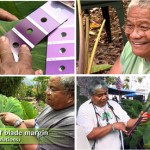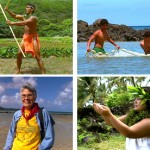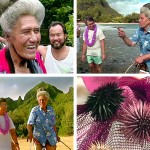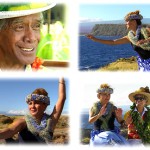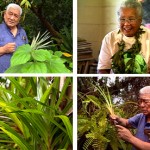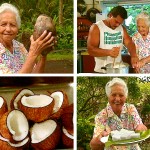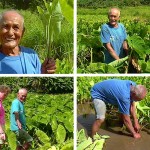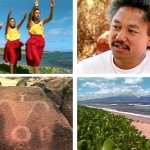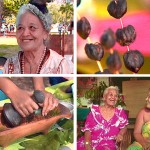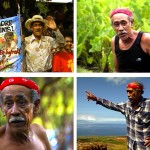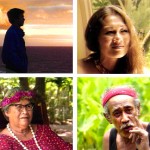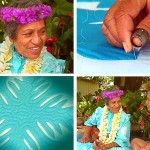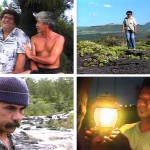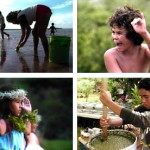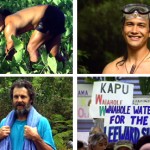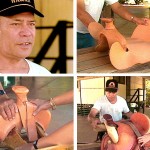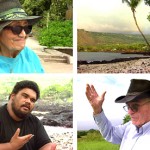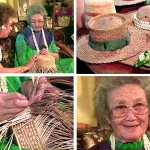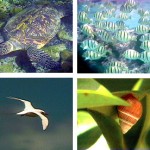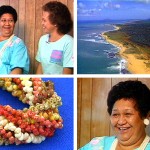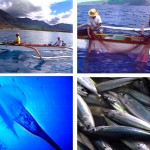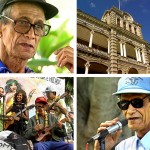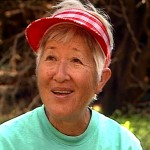Documenting Taro Varieties – with Jerry Konanui
Beginning with an overview of how to document taro varieties, Jerry Konanui documents plant descriptors for nine varieties of taro, harvested at the Amy Greenwell Ethnobotanical Garden in Kona, Hawai‘i island. Along with the documentation, Jerry shares a wealth of cultural knowledge of these varieties passed down to him through family. His goal is to scientifically document as many of the Hawaiian taro varieties as possible for reference by future generations of taro growers.
Ahupua‘a, Fishponds and Lo‘i
The Hawaiian system of land use allowed access to all resources in the ahupua‘a, a land division that stretched from mountain to sea. Within the ahupua‘a, highly specialized technologies such as fishponds and lo‘i kalo (taro gardens) ensured an abundance of food.
He Huaka‘i Māka‘ika‘i me Kupuna Rachel Nahaleelua Mahuiki
(“A walking tour with Kupuna Rachel Nahaleelua Mahuiki”)
Rachel Nahaleelua Mahuiki, one of Hanalei’s most beloved kūpuna (elders), leads Larry Kimura and a group of Hawaiian language teachers on a tour of Hā‘ena, Kaua‘i.
Ka Nani A‘o Ka‘ū – The Beauty of Ka‘ū
instructional hula video
A performance of the hula Ka Nani A‘o Ka‘ū
(The Beauty of Ka‘ū) by Debbie Ryder on location at Ka Lae, southernmost point on the island of Hawai‘i, plus an interview with beloved kumu hula (hula master) George Na‘ope about the composing of the song Ka Nani A‘o Ka‘u during a visit to Ka‘ū.
The Hawaiian Art of Healing
featuring Henry Auwae
From the age of five, Henry Auwae learned the art of lā‘au lapaʻau (herbal medicine) from his grandmother, a woman whose knowledge extended back to nineteenth century Hawai‘i. In this two-disk documentary series, “Papa” Auwae shares this traditional knowledge.
E Ho‘omākaukau Haupia me Kupuna Helen Haleola Lee Hong
(“Let’s make haupia with Kupuna Helen Haleola Lee Hong”)
Larry Kimura visits Helen Haleola Lee Hong at the Keliihoomalu family residence in Kaimū in the Puna district of Hawai‘i island, to learn how to prepare haupia (coconut pudding) and talk story about earlier times.
Nā Hulu Kūpuna – James Hueu, Jr.
Tuti Kanahele travels to the taro-growing district of Ke‘anae, Maui, to talk with James Keolaokalani Hueu, Jr., a long-time resident and taro grower.
Lāna‘i – A Rare Gift of Beauty
Sol Kahoohalahala takes a group of Hawaiian Studies teachers on a tour of his beloved island of Lāna‘i. From the ancient archaeological sites at Kaunolū to the Garden of the Gods and Lāna‘i Hale, the highest elevation on the island, Sol gives a living history of the island and its people.
Nā Hulu Kūpuna – Katherine Maunakea
Ku Kahakalau visits with Katherine Maunakea on the Wai‘anae coast. After relating a short history of her early life in Kula, Maui, in the Puna district of the Big Island and in Nānākuli on O‘ahu, Katherine shares her knowledge of lāʻau lapaʻau (medicinal plants), including noni, tī, kukui, laukahi and pōpolo.
Uncle Harry Kunihi Mitchell
Various interviews and other video footage of the beloved Maui kupuna (elder) of the Protect Kaho‘olawe ‘Ohana, Harry Kunihi Mitchell. Documentation covers the period from 1982 through 1989.
Nā Waiwai Hawai‘i – Treasured Values of Hawai‘i, Part 2 TRANSCRIPT
The Hawaiian word waiwai denotes something valued or treasured, true wealth. This program explores the concepts of ‘ohana (family), ho‘okipa (hospitality), and po‘okela (excellence).
Nā Hulu Kūpuna – Margaret Aipoalani
Tuti Kanahele visits with musician and Kaua‘i resident Margaret Aipoalani who demonstrates the techniques and patterns of Hawaiian quilting, tells stories of her younger days, and entertains with song, ʻukulele and piano.
Kapu Ka‘ū
Kapu Kaʻū is a unique portrait of one of Hawai‘i’s most remote and rugged districts, Ka‘ū, located on the southern flanks of Mauna Loa on the island of Hawai‘i. The people of Ka‘ū, known historically for their independence and resilience, relate stories of a lifestyle closely tied to the land and the sea.
Ka‘ū Oral Histories TRANSCRIPT
Transcripts of oral history interviews videotaped by Nā Maka o ka ‘Āina for Ka ‘Ohana o Ka Lae at various locations in Ka‘ū, including Punalu‘u and Ka Lae (South Point).
Nā Waiwai Hawai‘i – Treasured Values of Hawai‘i, Part 1 TRANSCRIPT
The Hawaiian word waiwai denotes something valued or treasured, true wealth. This program explores the concepts of aloha ‘āina (love for the land), kōkua (helpfulness), ‘ohana (family), and “thinking island.”
Kapu Ka‘ū TRANSCRIPT
A unique portrait of one of Hawai‘i’s most remote and rugged districts, Ka‘ū, located on the southern flanks of Mauna Loa on the island of Hawai‘i. The people of Ka‘ū, known historically for their fierce independence, relate stories of a lifestyle closely tied to the land and the sea.
Kalo Pa‘a o Waiāhole – Hard Taro of Waiāhole
This program explores the issues surrounding the allocation of water that flows in the Waiāhole Ditch on the island of O‘ahu. The title comes from an old saying referring to the stubbornness of the people of Waiāhole valley. This program documents their determination to regain the water that was taken from windward streams in the early 1900’s to irrigate sugar plantations on the drier leeward side.
Nā Hulu Kūpuna – Leimana Kanahele
Tuti Kanahele visits with her father, Leimana Kanahele, born and raised on the island of Ni‘ihau, now making his home on Kaua‘i. Leimana demonstrates the making of saddles, a skill acquired during his younger days working on a Ni‘ihau cattle ranch.
Nā Waiwai Hawa‘i – Treasured Values of Hawai‘i, Part 1
The Hawaiian word wai denotes something valued or treasured, true wealth. This program explores the concepts of aloha ‘āina (love for the land), kōkua (helpfulness), ‘ohana (family), and “thinking island.”
Kona Hema – South Kona
Kūpuna (elders) and residents relate cherished traditions regarding fishing, agriculture, place names and the ahupua‘a system of land management in the Kona district of Hawai‘i island.
Kona Hema – South Kona TRANSCRIPT
Kūpuna (elders) and residents relate cherished traditions regarding fishing, agriculture, place names and the ahupua‘a system of land management in the Kona district of Hawai‘i island. Together with county of Hawai‘i officials and representatives from the Kamehameha Schools, they envision a future for South Kona.
Nā Waiwai Hawai‘i – Treasured Values of Hawai‘i, Part 2
The Hawaiian word wai denotes something valued or treasured, true wealth. This program explores the concepts of ‘ohana (family), ho‘okipa (hospitality), and po‘okela (excellence).
Nā Hulu Kūpuna – Esther Makuaole
Tuti Kanahele visits Esther Makuaole who makes her home on Kaua‘i. Following a long-established tradition taught to her as a young girl in Kona, Esther skillfully weaves pāpale (hats) made of lau hala and other materials.
Lāhui Maoli – Native Species
An island-by-island survey of Hawaiian native species of birds, snails, fish and insects, all identified by their Hawaiian names and described through ‘ōlelo no‘eau (wise sayings) in Hawaiian and English.
Nā Hulu Kūpuna – Alina Kanahele
Tuti Kanahele interviews Alina Kanahele about everyday life on the island of Ni‘ihau, where Alina was born and raised.
Hōkai Ua Lawai‘a Makapa‘a
Miloli‘i style ‘ōpelu fishing
Set to the songs of the Kahumoku Brothers, this music video demonstrates a traditional Hawaiian method of catching ‘ōpelu (Pacific mackerel) off the Wai‘anae coast of O‘ahu.
Hali‘a Aloha – Thomas K. Maunupau, Jr.
This video contains short clips from various events at which Thomas Kananimauloa Maunupau, Jr., beloved kupuna and patriot, participated through words and song.
Aunty Dorothy Tao on Kaho‘olawe
Aunty Dorothy Tao of Kaua‘i visits the island of Kaho‘olawe during the 1989 Makahiki season, exploring the island with Uncle Harry Mitchell and the Protect Kaho‘olawe ‘Ohana, caring for the native plantings, and sharing her thoughts about the future of the island.

